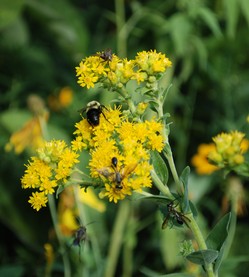Native plants: Sources of information to grow your knowledge

Stiff goldenrod (Solidago rigida) with some pollinating visitors.
Rick Meader | Contributor
I’ll talk much more about them next week, but this week I wanted to bring to your attention to some upcoming events related to native plants that you might want to attend. They’ll help you expand your knowledge much more quickly than this blog can hope to achieve. I also want to share with you a short laundry list of books and Web sites that I’ve found helpful in learning more about native plants.
Events/clubs:
So, let’s get on with what’s going on. On March 6-7, the Michigan Wildflower Association will be holding their annual conference in East Lansing. The list of speakers and seminars is quite impressive and is geared toward the average person (i.e. it’s not a scientific conference). If you go, you’ll be sure to learn something you might want to do with your own personal landscape, if you’re so inclined, or you might just learn something fun.
As I may have mentioned, I am a member of a national organization called Wild Ones. This organization, which has an Ann Arbor chapter, is devoted to the use of native plants in landscapes. I’ve acquired the lion’s share of my knowledge of native plants through Wild Ones meetings, field trips, plant rescues, and friendships I’ve formed through this group. It’s a very low-key, non-threatening group whose members are happy to share their knowledge with newcomers. The Wild Ones meetings are generally held the second Wednesday of every month.
The upcoming schedule has these topics:
March 10 (Wednesday) 6:45 p.m.- Matthaei Botanical Gardens
“Ives Road Fen Volunteerism”
April 19 (Monday - non-typical) 7:45 p.m. - Matthaei Botanical Gardens
“Insects as Pollinators”
Another, more scientific group (and also very friendly), is the Michigan Botanical Club. Occasionally, since their interests are so similar, the Wild Ones and Michigan Botanical Club will hold joint meetings, as the April meeting listed above will be. Their field trips (or forays) are pretty impressive, and they go far afield to observe native plants in their native splendor.
Books, pamphlets and Web sites:
In terms of printed or cyberspace sources of information, I am just going to list them here for you to investigate on your own, although there are a couple (for example, “Bringing Nature Home”), that I will be talking about in more detail in future blog entries. So have fun with these, and I’ll be in touch next week.
Web sites:
Native Plant Nursery (Ann Arbor, MI) - www.nativeplant.com - Excellent local plant source with pictures of native plants they sell.
Wildtype Nursery (Mason, MI) - www.wildtypeplants.com - Another excellent local plant source with information on plants growing habits, blooming times and growing conditions.
City of Ann Arbor Natural Areas Preservation Web site http://www.a2gov.org/government/publicservices/fieldoperations/NAP/NativePlants/
Pages/NativePlants.aspx - a discussion of local native plants.
USDA Natural Resources Conservation Service Plants Database - http://plants.usda.gov/ - This is a pretty technical source, but often has good photos of plants, and information on the plants’ ranges.
The Nature Conservancy Global Invasive Species Team - http://tncinvasives.ucdavis.edu/
Prairie Nursery (Wisconsin) - www.prairienursery.com - A source for Great Lakes species, but not generally Michigan, genotype plants or seeds.
Connecticut Botanical Society http://www.ct-botanical-society.org/garden/garden2.html - this site has photos and descriptions of some native plants that are also native to Michigan.
Books:
Bringing Nature Home by Douglas W. Tallamy
Michigan Trees by Burton V. Barnes and Warren H. Wagner, Jr.
Native Trees Shrubs, and Vines for Urban and Rural America: A Planting Design Manual for Environmental Designers by Gary L. Hightshoe. A big book that gives very detailed information about the growing habits and cultivation of native trees and shrubs in the United States. Not all are native to Michigan, but many are.
Pamphlets:
Native Plant series of pamphlets published by the City of Ann Arbor - an excellent source of information for locally native plants ranging from herbaceous to woody plants.
http://www.a2gov.org/government/publicservices/fieldoperations/NAP/Documents/
fieldoperations_nap_form_NativeBrochures_2009-01-05.pdf
As I learn of and remember more Web sites and books, I’ll share them with you. In the meantime, get out and enjoy nature!
Rick is a local landscape architect with a special interest in all things natural, including native plants and the critters that eat them. You can contact him at yourland1824@gmail.com.


Comments
Rick Meader
Tue, Feb 16, 2010 : 5:47 p.m.
Rork, I'm very glad you're enjoying the posts. A book we used in my U of M Woody Plants course was "Shrubs of Ontario" by James H Soper. It had very good descriptions of the shrubs and line drawings for illustrations. In looking this answer up, I also found another site related to Canadian plants that has links to other sites with excellent photographs of plants native to Canada, many of which are also native to Michigan. The website is www.wildontario.com, and it links you to his other sites such as www.ontariotreesandshrubs.com. Take a look!
Rork Kuick
Tue, Feb 16, 2010 : 2:36 p.m.
I'm really liking these posts. Could you or others advise me on a good woody plants ID book for our area. I have Michigan Trees, and many herb books, but those little bushy guys can be hard, particularly now. I realize you might have to suggest a book with broader coverage that will include hundreds of plants that we won't see right here - oh well. (I've been farther south, and am very humbled by the woody plants, whereas with herbs it is our area that humbles most visitors.)